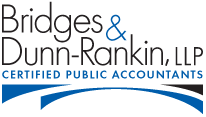The New Partnership Tax Return Audit Rules
By Kenneth H. Bridges, CPA, PFS February 2017
The partnership format (which includes most LLCs) is a very popular entity choice for income tax purposes, because it provides flow-through treatment (i.e. no risk of double taxation, and ability to pass tax losses through to the owners) and greater flexibility than does the S-corp format (e.g. no limit on number or type of owners, ability to specially allocate income or losses, ability to provide for preferred returns, etc.). From the IRS’ perspective, however, they are much more difficult from an examination perspective.
When an IRS examination of a C-corp or an individual results in an adjustment, the IRS simply assesses the tax against that corporation or individual. With respect to a partnership, however, the IRS must flow the adjustment through to the partners (including, potentially, many tiers of partnerships) and assess the ultimate owners. For partnerships with numerous owners or multiple tiers of ownership, this can be a time-consuming, cumbersome, and expensive process for the IRS.
In 1982 (TEFRA), Congress sought to provide the IRS some relief in dealing with larger partnerships (generally those with more than 10 partners or with another flow-through entity as a partner), enacting consolidated audit procedures whereby the IRS could handle the examination largely at the partnership level and deal primarily with an appointed Tax Matters Partner. This streamlined the examination process itself somewhat for the IRS, but the IRS still must flow any adjustments through to the ultimate owners and deal with the actual tax computations and assessment at the partner level.
In late 2015, Congress passed new legislation (the Bipartisan Budget Act of 2015, or BBA) making substantial changes to the partnership audit rules. The rules are extremely complex (e.g. the proposed regulations which came out in January 2017 are 277 pages long), but the basic gist of the rules is that the IRS can deal solely with a designated partnership representative and assess the tax directly at the partnership level.
There are special provisions under which certain partnerships may elect out of the new rules, and provisions under which a partnership may elect to push the adjustment out to the partners.
The new rules first take effect (unless you elect for earlier application) for tax returns for years 2018 or later. They are complex and controversial, and may be repealed before ever actually taking effect. However, if you are forming a new partnership or considering investing in or buying an interest in an existing partnership, you should give careful consideration to whether and how these new rules are addressed by the partnership agreement. Otherwise, you could potentially find yourself bearing the economic cost of an IRS adjustment to an item from which you never derived a tax benefit.
Kenneth H. Bridges, CPA, PFS is a partner with Bridges & Dunn-Rankin, LLP an Atlanta-based CPA firm.
This article is presented for educational and informational purposes only, and is not intended to constitute legal, tax or accounting advice. The article provides only a very general summary of complex rules. For advice on how these rules may apply to your specific situation, contact a professional tax advisor.
